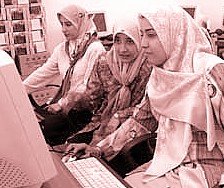In locked-down Baghdad, city life moves online
 BAGHDAD, Oct 2 (Reuters) - In the endless daily battle against the fear and isolation of life under lock-down, the people of Baghdad have found a way to keep their city alive: moving it online.
BAGHDAD, Oct 2 (Reuters) - In the endless daily battle against the fear and isolation of life under lock-down, the people of Baghdad have found a way to keep their city alive: moving it online.Instead of enjoying an outdoor meal at one of the fish restaurants along the Tigris embankment, 28-year-old housewife Dunya Saad spends her evenings at the computer in her living room, chatting with her friends on Yahoo! Messenger.
Most of her relatives and friends live on the far side of the Tigris, and seeing them in person is nearly impossible.
"It's sad not to see your friends like in the good old days," she sighed. "But online chatting has made things better."
Since the February bombing of a Shi'ite shrine in Samarra sparked a wave of sectarian bloodshed, the Internet has gone from being a hobby for tech-savvy enthusiasts to a mass replacement for the daily interactions of city life.
In Baghdad, shops close early. Cars are not permitted on the streets after 9:00 p.m. Many parts of the city are completely deserted by sunset.
Hundreds of thousands of people have been forced to move to parts of the city where they do not know the neighbours.
"I only go out on emergencies like attending a funeral or visiting a doctor," said Zainab, 35, an office secretary who asked to be identified by her first name. "Honestly, the outside craziness freaks me out."
She has not seen her friends for months. Instead, she meets them over online video-conferences.
"Most of the time we talk about the security situation. Who had been killed, kidnapped, or recently fled the country."
Moving Baghdad into cyberspace has been a feat of free- market ingenuity.
Perhaps the hardest part is electricity. Much of Baghdad had electricity for 12-18 hours a day before the U.S.-led invasion in 2003. Most neighbourhoods now get electricity from the grid for just four to six hours a day.
It means ordinary people have to know their ohms from their amperes and their megabits from their kilohertz.
Most middle class households now have cables snaking down the street to a neighbourhood "generator man" who gives them diesel-generated power for a monthly fee of about $10 per ampere. Six or seven amperes are usually enough for a computer, a TV and a fridge. An air conditioner costs more.
A neighbourhood Internet cafe will sell a subscription for wireless Wi-Fi access to its satellite broadband hookup for about $40 a month.
Read the rest at Reuters/Alternet

<< Home